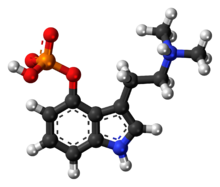
Back سيلوسيبين Arabic Psilocibina AST سیلوسایبین AZB Псилоцибин Bulgarian Psilocibina Catalan Psilocybin Czech Psilocybin Welsh Psilocybin Danish Psilocybin German Ψιλοκυβίνη Greek

| |

| |
| Names | |
|---|---|
| Preferred IUPAC name
3-[2-(Dimethylamino)ethyl]-1H-indol-4-yl dihydrogen phosphate | |
| Identifiers | |
3D model (JSmol)
|
|
| 273158 | |
| ChEBI | |
| ChEMBL | |
| ChemSpider | |
| ECHA InfoCard | 100.007.542 |
| EC Number |
|
| KEGG | |
| MeSH | Psilocybine |
PubChem CID
|
|
| RTECS number |
|
| UNII | |
CompTox Dashboard (EPA)
|
|
| |
| |
| Pharmacology | |
| Low | |
| Oral, intravenous | |
| Pharmacokinetics: | |
| Hepatic | |
| Oral: 163±64 min Intravenous: 74.1±19.6 min[1] | |
| Renal | |
| Legal status |
|
| Properties | |
| C12H17N2O4P | |
| Molar mass | 284.252 g·mol−1 |
| Melting point | 220–228 °C (428–442 °F)[3] |
| Soluble | |
| Solubility | Soluble in boiling methanol and water slightly soluble in ethanol insoluble in chloroform, benzene[4] |
| Hazards | |
| Lethal dose or concentration (LD, LC): | |
LD50 (median dose)
|
285 mg/kg (mouse, i.v.) 280 mg/kg (rat, i.v.) 12.5 mg/kg (rabbit, i.v.)[3] |
Except where otherwise noted, data are given for materials in their standard state (at 25 °C [77 °F], 100 kPa).
| |
Psilocybin[a] (/ˌsaɪləˈsaɪbɪn/ sy-lə-SY-bin, /ˌsɪl-/) is a naturally occurring psychedelic prodrug compound produced by more than 200 species of fungi. The most potent are members of genus Psilocybe, such as P. azurescens, P. semilanceata, and P. cyanescens, but psilocybin has also been isolated from about a dozen other genera. Psilocybin is itself biologically inactive but is quickly converted by the body to psilocin, which has mind-altering effects similar, in some aspects, to those of lysergic acid diethylamide (LSD), mescaline, and dimethyltryptamine (DMT). In general, the effects include euphoria, visual and mental hallucinations, changes in perception, distorted sense of time, and perceived spiritual experiences. It can also cause adverse reactions such as nausea and panic attacks.
Imagery found on cave paintings and rock art of modern-day Spain and Algeria suggests that human use of psilocybin mushrooms predates recorded history. In Mesoamerica, the mushrooms had long been consumed in spiritual and divinatory ceremonies before Spanish chroniclers first documented their use in the sixteenth century. In 1958, the Swiss chemist Albert Hofmann isolated psilocybin and psilocin from the mushroom Psilocybe mexicana. Hofmann's employer Sandoz marketed and sold pure psilocybin to physicians and clinicians worldwide for use in psychedelic therapy. Although the increasingly restrictive drug laws of the 1960s and the 1970s curbed scientific research into the effects of psilocybin and other hallucinogens, its popularity as an entheogen (spirituality-enhancing agent) grew in the next decade, owing largely to the increased availability of information on how to cultivate psilocybin mushrooms.
The intensity and duration of the effects of psilocybin are variable, depending on species or cultivar of mushrooms, dosage, individual physiology, and set and setting, as was shown in experiments led by Timothy Leary at Harvard University in the early 1960s. Once ingested, psilocybin is rapidly metabolized to psilocin, which then acts on serotonin receptors in the brain. The mind-altering effects of psilocybin typically last from two to six hours, although to individuals under the influence of psilocybin, the effects may seem to last much longer, since the drug can distort the perception of time. Possession of psilocybin-containing mushrooms has been outlawed in most countries, and psilocybin has been classified as a Schedule I controlled substance under the 1971 United Nations Convention on Psychotropic Substances.
- ^ Cite error: The named reference
Passie2002was invoked but never defined (see the help page). - ^ Anvisa (July 24, 2023). "RDC Nº 804 - Listas de Substâncias Entorpecentes, Psicotrópicas, Precursoras e Outras sob Controle Especial" [Collegiate Board Resolution No. 804 - Lists of Narcotic, Psychotropic, Precursor, and Other Substances under Special Control] (in Brazilian Portuguese). Diário Oficial da União (published July 25, 2023). Archived from the original on August 27, 2023. Retrieved August 27, 2023.
- ^ a b Merck Index, 11th Edition, 7942
- ^ "Psilocybine". PubChem, US National Library of Medicine. August 27, 2022. Retrieved August 29, 2022.
- ^ Cite error: The named reference
Pubchemwas invoked but never defined (see the help page).
Cite error: There are <ref group=lower-alpha> tags or {{efn}} templates on this page, but the references will not show without a {{reflist|group=lower-alpha}} template or {{notelist}} template (see the help page).
© MMXXIII Rich X Search. We shall prevail. All rights reserved. Rich X Search